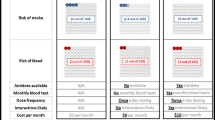Abstract
We review current state-of-the-art practices for combining preference data from multiple sources and discuss future research possibilities. A central theme is that any one data source (e.g., a scanner panel source) is often insufficient to support tests of complex theories of choice and decision making. Hence, analysts may need to embrace a wider variety of data types and measurement tools than traditionally have been considered in applied decision making and choice research. We discuss the viability of preference-stationarity assumptions usually made when pooling data, as well as random-utility theory-based approaches for combining data sources. We also discuss types of models and data sources likely to be required to make inferences about and estimate models that describe choice dynamics. The latter discussion is speculative insofar as the body of literature on this topic is small.
Similar content being viewed by others
References
Adamowicz, W., J. Louviere and M. Williams (1994), Combining Stated and Revealed Preference Methods for Valuing Environmental Amenities, Journal of Environmental Economics and Management, 26:271–292.
Alberini, Anna (1992), The Informational Content of Binary Responses, Ph.D. Dissertation, University of California, San Diego.
Bazerman, Max H., Loewenstein, George F., White, Sally B. (1992), “Reversals of Preference in allocation decisions: Judging an alternative versus choosing among alternatives”. Administrative Science Quarterly. Vol 37(2), 220–240.
Ben-Akiva, M. and Morikawa, T. (1990) “Estimation of switching models from revealed preferences and stated intentions, ” Transportation Research, 24A(6):485–495.
Ben-Akiva, M., Bradley, M., Morikawa, T., Benjamin, J., Novak, T., Oppewal, H. and Rao, V. (1994) “Combining Revealed and Stated Preferences Data” Marketing Letters: Special Issue on the Duke Invitational Conference on Consumer Decision-Making and Choice Behavior, 5(4).
Blamey, R. K., Bennett, J. W., Morrison, M. D. and J. J. Louviere (1998), “Divergences in revealed and stated preferences and the effect of social desirability prompts: validation of a choice experiment involving green product choice”, Paper presented to the Biennial Conference of the International Society for Ecological Economics, Santiago, Chile, November 15–19.
Brewer, A. and Hensher, D. A. “Distributed Work and Travel Behaviour: The Dynamics of Interactive Agency Choices Between Employers and Employees” presented at the 8th IATBR Conference on Travel Behaviour Research, Austin, Texas, September 1997.
Bunch, David S., “Information and Sample Size Requirements for Estimating Non-IID Discrete Choice Models Using Stated-Choice Experiments, ” Working Paper UCD GSM 0399, Graduate School of Management, University of California, Davis, February 1999.
Burke, Raymond R. Harlam, Bari A. Kahn, Barbara E. Lodish, Leonard M. (1992), “Comparing Dynamic Consumer Choice in Real and Computer-Simulated Environments”, Journal of Consumer Research. 19(1): 71–82.
Cameron, W. D. Schulze, R. G. Ethier, and G. L. Poe (1998), “Alternative Nonmarket Value-Elicitation Methods: Are the Underlying Preferences the Same?” working paper, Department of Economics, UCLA.
Cooper, Lee G., and Masao Nakanishi (1988), Market-Share Analysis. Norwell, MA: Kluwer Academic Publishers.
Erdem, Tulin. Keane, Michael P. (1996), “Decision-making under uncertainty: Capturing dynamic brand choice processes in turbulent consumer goods markets”. Marketing Science. 15(1): 1–20.
Gonul, Fusun. Srinivasan, Kannan (1996), “Estimating the impact of consumer expectations of coupons on purchase behavior: A dynamic structural model. ” Marketing Science. 15(3): 262–279.
Guadagni, P. M. and J. D. C. Little (1983), “A Logit Model of Brand Choice Based on Scanner Data”, Marketing Science, 2(Summer), 203–238.
Geweke, J. F. and M. P. Keane (1999), “Bayesian inference for dynamic discrete choice models without the need for dynamic programming, ” In Mariano, Schuman and Weeks (Eds.) Simulation Based Inference and Econometrics, Cambridge, UK: Cambridge University Press, Forthcoming.
Hensher, D. A. and M. Bradley (1993), Using stated response data to enrich revealed preference discrete choice models, Marketing Letters, 4(2):39–152.
Hutchinson, J. W., Kamakura, W. A. and J. G. Lynch (1997) “Unobserved heterogeneity as an alternative explanation for “reversal” effects in behavioral research, ” Unpublished working paper, Dept. of Marketing, Wharton School of Business, U. of Pennsylvania, November.
Irwin, Julie R. (1994), “Buying/selling price preference reversals: Preference for environmental changes in buying versus selling modes. ” Organizational Behavior & Human Decision Processes. Vol 60(3), Dec., 431 457.
Irwin, Julie R., and Meyer, Robert J. (1999): “Training the multilingual judge: the effects effects of learning on response-mode effects in multiattribute decision making”, Working Paper, Department of Marketing, the Wharton School of Business.
Johnson, Eric J., Meyer, Robert J. (1984), “Compensatory choice models of noncompensatory processes: The effect of varying context”. Journal of Consumer Research. Vol 11(1), Jun 1984, 528–541.
Johnson, Eric J., Meyer, Robert, Hardie, Bruce, and Walsh, John (1998), “Process-Assisted Choice Modeling”, Working paper, Wharton School of Business, University of Pennsylvania.
Kagel, John, and Roth, Alvin (1995), Handbook of Experimental Economics, Princeton
Author information
Authors and Affiliations
Rights and permissions
About this article
Cite this article
Louviere, J.J., Meyer, R.J., Bunch, D.S. et al. Combining Sources of Preference Data for Modeling Complex Decision Processes. Marketing Letters 10, 205–217 (1999). https://doi.org/10.1023/A:1008050215270
Issue Date:
DOI: https://doi.org/10.1023/A:1008050215270




